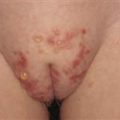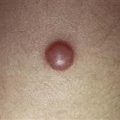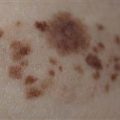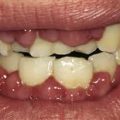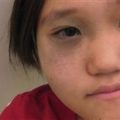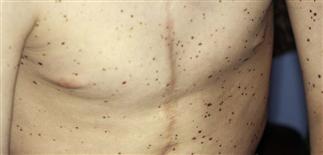
Child with multiple lentignes of LEOPARD syndrome. Note scar from correction of pulmonary stenosis.
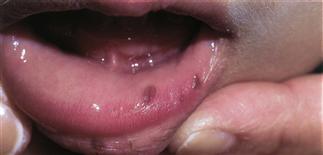
Lip lentigines in teen with Peutz–Jegher syndrome.
CLINICAL FEATURES
Lentigines are flat, dark brown to black 1–5-mm macules seen anywhere on skin or occasionally on mucosal surfaces. They first appear between ages 5 to 10 and are not influenced by sun. Multiple lentigines are found in several syndromes: On the face, trunk and extremities in Moynahan’s LEOPARD syndrome (Lentigines, Electrocardiograph abnormalities, Ocular hypertelorism, Pulmonary stenosis, Abnormalities of genitalia, Retardation of growth, and Deafness); in the Carney complex of nevi, myxoid neurofibromas and central facial lentigos; and on the lips in the autosomal dominant Peutz–Jegher syndrome. In Peutz–Jegher syndrome, lentigines are associated with multiple bowel polyps and a risk of gastrointestinal and genitourinary carcinomas. Moynahan’s LEOPARD syndrome is the result of mutations in the PTPN 11 gene, the Peutz–Jegher syndrome in PJS, STK11 and LKB1 genes and the Carney complex in PRKARIA gene. Multiple lentigines including mucosal lentigines also can be found in children without associated syndromes.
TREATMENT
The child with multiple lentigines should have a detailed history and physical examination looking for associated problems. Referral to appropriate specialists is guided by the findings. No treatment of the lentigines is necessary although good results have been seen with pigment selective lasers.

